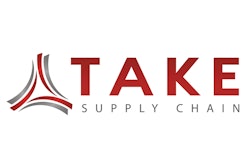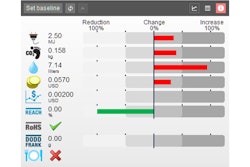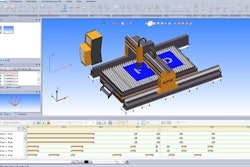In order to keep up with the rapid progression toward supply chain precision by business-to-consumer giants like Amazon and Zappos, mid-market companies need to shake off the dust from last decade’s recession, and re-evaluate their technology capabilities and shortcomings. Advances in supply chain tools and solution delivery now make the decision to upgrade far more affordable and far less disruptive than ever before.
Customers who are acclimated to the level of service now provided by multinational brands already started holding mid-market businesses to higher standards. I anticipate this expectation to only increase as companies of all market cap sizes become more automated and advanced. If your legacy technology is costing more than the value it adds, inhibiting growth or obstructing competitive advantage, you should consider upgrading your current systems. This article highlights three of the most promising new supply chain technologies available and explains how your company can leverage them for supply chain efficiencies right away.
1. Software as a Service and Cloud
Gartner predicts that, by 2016, more than 40 percent of new logistics applications may be delivered via the cloud, meaning an information storage and distribution channel that was barely considered 10 years ago may soon control workflow for nearly half of the world’s supply chains. Despite growing interest and early signs of acceptance, however, cloud computing within direct materials supply chain management remains a relatively recent phenomenon. It has a lower level of penetration than customer relationship management or indirect procurement offerings often do. This is still good news for your supply chain, though. Establishing the right level of operations in the cloud helps you be better positioned to reduce spend year over year, minimize potential disruptions, lower expansion costs and risks, and widen the gap on your competition.
Cloud computing enables mid-market companies to set up warehouse and logistics operations quickly in areas without established infrastructure, creating a warehouse in the cloud. Companies can access software and data stored in the cloud, and immediately begin to set up operations on site. This efficiency dramatically reduces the normal amount of time required to implement information technology (IT) systems and coordinate operations. It also improves your supply chain’s long-term efficiency, resilience and agility.
Software as a service (SaaS) adoption also:
- Can represent an operational expense as opposed to a capital investment.
- Significantly reduces manual labor by extending automated processes to a larger percentage of the supply base.
- Increases standardization of supply chain functions across trading partners.
- Offers regular updates and improvements to the solution, typically at no additional cost.
So, how do you know if your company is ready for a cloud and/or SaaS solution upgrade? Here are some questions to consider:
- How many work-arounds and living with shortcomings are experienced with your legacy systems?
- Is your legacy system expensive to maintain (licenses, hardware, skill sets, etc.)?
- Is a desktop-only system hampering employee productivity and increasing errors?
If any of these are true, now may be the time to explore and invest in cloud-based supply chain solutions for your company.
2. Monitoring and Notification Technology
Working in a multi-variable and constantly moving supply chain means hours and even minutes can be critical in workflow. New notification technology provides real-time, rules-based alerts that accelerate workflow and facilitate issue resolution. Below are a couple of examples:
- Real-time tracking: Real-time tracking is not a novel technology, however, it is historically limited in its implementation due to cost and inadequate communication channels. Fortunately, each of these is no longer a barrier. Affordable solutions are now available that can be programmed to provide ongoing updates, as well as alert stakeholders to anomalies in the supply chain. Resolution/next-step messages can also be served to the recipients to minimize the impact of the disruption.
- Product recalls: Nowadays, the public and the media are demanding that recall-affected customers be notified, and the recall process begin, within days rather than weeks or months. With notification technology in place, mid-market companies can handle recalls far more quickly and efficiently. Notifications and instructions can be sent to parties up and down the supply chain instantly via a single automated alert, regardless if the goods shipped to a dozen or tens of thousands of customers.
Once again, let’s consider some questions for mid-market business:
- Do you lose track of or experience late inbound shipments, and do they result in disgruntled customers or lost profits?
- Do employees and outsourcers complain about lack of visibility and ability to pinpoint the origin of the disruption when problems occur?
- Have you ever recalled a product, and are you fully prepared for a recall if (and when) it occurs?
If you answered even a partial yes to any of the above, it may be time to explore upgrading your monitoring and notification technology.
3. Advanced Wireless: Voice, Data and GPS; and Speech Recognition
Today’s leading cellular carriers offer rugged handheld computers that enable managers, operators, handlers, and outsourcers to all maintain instantaneous and continuous communication through voice, data and global positioning system (GPS) technology. These impact-resistant smart devices provide employees with 24/7 access to data, global positioning information and cell phone functionality.
Because of these multi-use devices, supply chain operators don’t need to worry about maintaining separate, fully charged cell phones, computers and GPS units. More importantly, they don’t have to constantly switch back and forth between multiple single-use devices to accomplish their daily activities. Merging data, GPS and voice capabilities into singular, integrated communication devices can reduce the number of IT systems that system administrators need to support, maintain and repair by 50 to 66 percent according to Intermec Technologies Corporation.
Aided by Siri, Google Now and Cortana, we were able to talk to our smart devices for the past few years. Some of the newest supply chain technology, however, represents the next wave of speech recognition software. On the warehouse floor, where employees place a premium on being able to use their hands to complete a myriad of tasks, the ability to give a verbal instruction to a computer or electrical device cannot be overvalued. Speech recognition can also lead to automation that, once again, can save your company important training and labor costs.
Before jumping into the advanced wireless/speech recognition market, however, mid-market business owners should ask themselves the following:
- Are your employees on your supply chain constantly switching back and forth between their personal and work mobile devices? Do they use their personal devices for work-related tasks, like communication or GPS?
- Do mobile devices ever break while being used on your supply chain line? Does the fear of such a break prevent mobile use in some cases?
- Would speech-recognition software free up your employees to use their hands for other tasks?
It’s true that national brands significantly raised the bar when it comes to creating and maintaining precision supply chains. However, mid-market businesses shouldn’t shy away from these increased expectations. Well-designed supply chains and new tools are making it easier to compete and win against larger competition.
The above are just a few of the many new technologies available, and now more affordable, for mid-market companies. By leveraging the ones most impactful to your bottom line, your company can continue to compete at higher levels—with instant revenue savings, happier employees and better serviced customers.
Donna Fritz is the vice president of marketing and product management for TAKE Supply Chain, and leverages more than twenty years of experience in marketing, product development and supply chain operations in her role. In addition to overseeing market and product strategy, she works closely with industry analysts, TAKE Supply Chain’s sales and services departments, and existing customers to ensure solutions continue to meet evolving customer needs and market opportunities.














